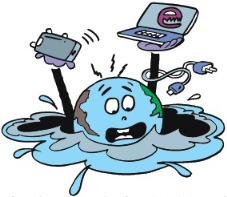September-19: Environment SnippetsÂ
- Posted by CERC India
- Posted in september
Tsunami of e-waste’ to hit the world soon: UN reportÂ
A “tsunami of e-waste†is to hit the world, the United Nations (UN) has warned. Last year electronic and electrical waste reached 48.5 million tonnes and this figure is expected to double. E-waste comprises not just electronic items – computers, screens, smartphones, but also all electrical equipment that involves anything with a plug, electric cord or battery.  E-waste contains substances that are hazardous to human health, including, mercury, cadmium and lead. E-waste can pollute water sources and food-supply chains. India figures as one of the regions that receives bulk of the e-waste export.
Say no to use and thrownÂ
Human waste an asset to economy, environmentÂ
Best out of waste
Human waste might be an unpleasant public health burden, but scientists at the University of Illinois see it as full of nutrients that can be recycled into valuable products that could promote agricultural sustainability and better economic independence for some developing countries. The study, published in the journal Nature Sustainability, describes 17 potential ecosystem services made available from the nutrients, water and organic material recovered from sanitation. These include water purification, nutrient cycling, food provisioning and climate regulation. The researchers identified ways in which the recovered resources and ecosystem services would be a value addition to society. For example, nutrients recovered from a wastewater facility can be applied to farmland to increase food production.
Innovative ideasÂ
Govt must take stock of piling up solar panel wasteÂ
Time to take action
The solar power usage in India is in its infant stage, but solar energy installed capacity has increased by over eight times—from 2.63 GW in 2014 to 26 GW in 2018. According to a report of the International Renewable Energy Agency (IRENA), India will have solar photovoltaic of 600 GW by 2050. It has been reported that India will generate solar panel waste between 1 and 1.2 million tonne per annum which is growing at a high speed. These solar panels are essentially made up of glass, metals, silicon and polymer fractions which are classified as potentially hazardous.
Currently the solar waste is guided by the e-Waste Management Rules, 2016, which puts the onus of disposal on manufacturers under the Extended Producer Responsibility (EPR). But there is no clarity on to how the country will handle its solar waste. The Government must think on the lines of EPR, which is meant for electronic goods.
Responsibly disposing




